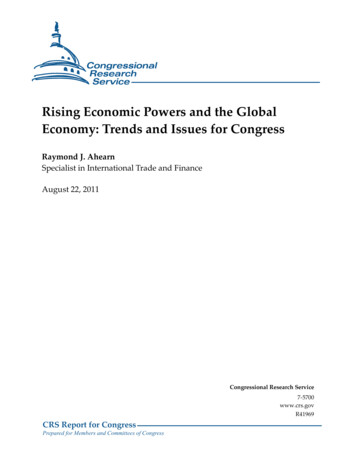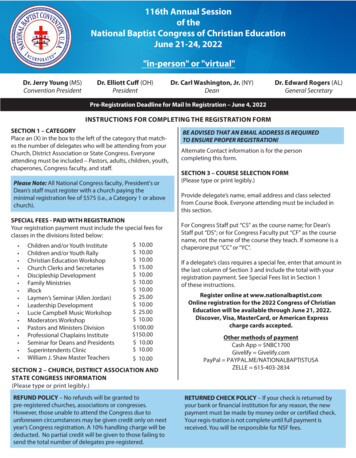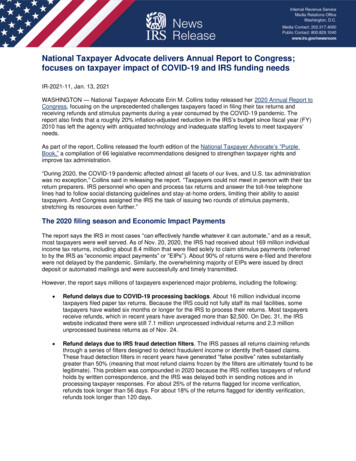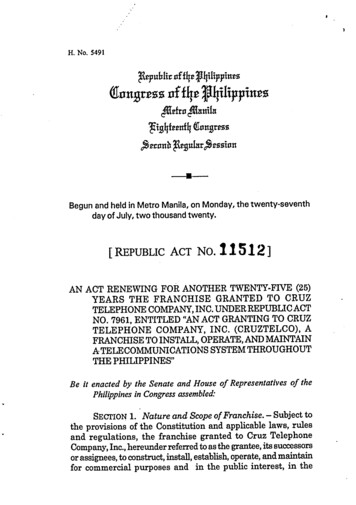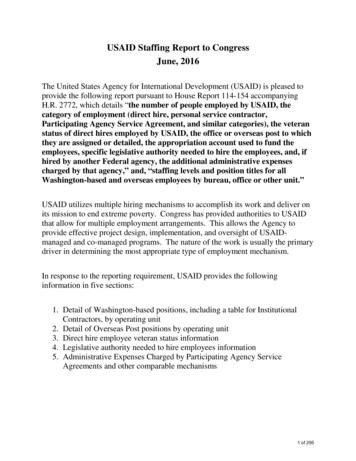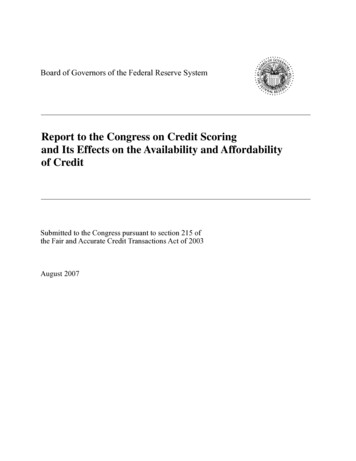
Transcription
Board of Governors of the Federal Reserve SystemReport to the Congress on Credit Scoringand Its Effects on the Availability and Affordabilityof CreditSubmitted to the Congress pursuant to section 215 ofthe Fair and Accurate Credit Transactions Act of 2003August 2007
(This page intentionally blank.)
CONTENTSEXECUTIVE SUMMARY .S-1OVERVIEW OF THE REPORT . O-1Overview figures .O-25***Introduction . 3Scope of the Report . 5Public comment on the study . 5Approaches considered in conducting the study . 5Types of credit-scoring models . 8Reasons for focusing on generic credit history scoring models . 8General Background . 10Credit-risk evaluation systems . 10Emergence of credit scoring. 12Changing patterns of credit use . 12Credit-reporting agencies . 13Developing and estimating credit-scoring models . 18Generic credit history scores . 22The current uses of credit scores . 29The Effects of Credit Scoring onthe Availability and Affordability of Credit . 32Expected effects of credit scoring . 35Evidence on the effects of credit scoring . 39Evidence from the Survey of Consumer Finances on the effects ofcredit scoring on access to credit and on the use of credit . 42Credit Scoring and Demographic Groups:Defining Differential Effect . 49Discrimination and lending markets. 50Defining differential effect for this study . 54The Data and Model. 57Data used for this study . 57Developing the credit-scoring model used in the present study . 68Estimating the model. 73The FRB base model . 76iii
ivReport to the Congress on Credit ScoringFindings on Loan Performance andCredit Availability and Affordability . 79The three credit scores used in the study. 79The distribution of credit scores . 80Multivariate analysis of differences in credit scores . 82The stability of credit-score differences over time . 84Credit scores and performance . 85Credit scores and credit availability and affordability. 94Accounting for economic and financial factorsnot available in this study. 97Findings on Differential Effect . 100Correlations between credit characteristics and bothperformance and demographics. 100Attributing differences in mean credit scores across differentpopulations to specific credit characteristics includedin the FRB base model . 103Dropping credit characteristics from the FRB base model. 106Adding credit characteristics to the FRB base model. 108Addressing differential effects using race-neutraland age-neutral credit-scoring models. 109Implications of finding differential effects. 116Limitations of the Analysis . 118* * *Appendix A: Section 215 of the Fair and Accurate CreditTransactions Act of 2003 . 121Appendix B: The 312 Credit Characteristics in the TransUnionDatabase of Credit Records Supplied for This Study. 123Appendix C: The 19 Credit Characteristics Selected from theTransUnion Database for Use in theFRB Base Model Scorecards. 131Tables . 133Figures . 233
EXECUTIVE SUMMARYCredit scoring is a statistical technology that quantifies the credit risk posed by aprospective or current borrower. The technique is widely used to evaluate applicationsfor credit, identify prospective borrowers, and manage existing credit accounts. Thelarge savings in cost and time that have accompanied the use of credit scoring aregenerally believed to have increased access to credit, promoted competition, andimproved market efficiency.The expansion of the use of credit scoring, including by the adaptation of itsmethodology to insurance markets, has been accompanied by concerns that it may affectthe availability and affordability of credit and insurance and that factors included incredit-scoring models may have adverse effects on certain populations, particularlyminorities. Section 215 of the Fair and Accurate Credit Transactions Act of 2003 (FactAct) directs the Federal Reserve Board and the Federal Trade Commission (FTC) tostudy how credit scoring has affected the availability and affordability of credit andinsurance, to determine the relationship between credit scores and actual credit losses andinsurance claims, and to determine how these relationships vary for the population groupsprotected under the Equal Credit Opportunity Act (ECOA).1 In addition, section 215directs the Board and the FTC to study the extent to which the consideration of certainfactors included in credit-scoring and insurance-scoring models could have a negative ordifferential effect on populations protected under ECOA and the extent to whichalternative factors could be used in credit scoring to achieve comparable results with lessnegative effect on protected populationsIn preparing the study, the Federal Reserve took the lead in assessing the effectsof credit scoring on credit markets, the subject of the present document; the FTC took thelead in the area of insurance and has issued a separate report on that topic.In the broadest terms, the findings of the Federal Reserve study are as follows:(1) The credit history scores evaluated here are predictive of credit risk for thepopulation as a whole and for all major demographic groups. That is, over any creditscore range, the higher (better) the credit score, the lower the observed incidence ofdefault. These conclusions are limited to credit history scores, that is, scores calculatedexclusively on the basis of individuals’ credit records as assembled by the three nationalcredit-reporting agencies (Equifax, Experian, and TransUnion). Other kinds of creditscores were not studied here.(2) Results obtained with the model estimated especially for this study suggestthat the credit characteristics included in credit history scoring models do not serve as1The Fact Act, Public Law 108-159, enacted December 4, 2003; section 215 is reproduced inappendix A of this report.S-1
S-2Report to the Congress on Credit Scoringsubstitutes, or proxies, for race, ethnicity, or sex. The analysis does suggest, however,that certain credit characteristics serve, in part, as limited proxies for age. A result of thislimited proxying is that the credit scores for older individuals are slightly lower, andthose of younger individuals somewhat higher, than would be the case had these creditcharacteristics not partially proxied for age. Analysis shows that mitigating this effect bydropping these credit characteristics from the model would come at a cost, as these creditcharacteristics have strong predictive power over and above their role as age proxies.Evidence also shows that recent immigrants have somewhat lower credit scoresthan would be implied by their performance. This finding appears to derive from the factthat the credit history profiles of recent immigrants resemble those of youngerindividuals, whose credit performance tends to be poor relative to the rest of thepopulation. Expanding the information supplied to credit-reporting agencies to includerent, other recurring bill payments, nontraditional uses of credit, and the credit historiesof the foreign-born in their countries of origin may provide a broader picture of the creditexperiences of recent immigrants and other individuals.(3) Different demographic groups have substantially different credit scores, onaverage. For example, on average, blacks and Hispanics have lower credit scores thannon-Hispanic whites and Asians, and individuals younger than age 30 have lower creditscores than older individuals. Also, for given credit scores, credit outcomes—includingmeasures of loan performance, availability, and affordability—differ for differentdemographic groups. Data limitations (for example, regarding individuals’ wealth,employment, and education) prevented a complete assessment of these differences inscore averages and outcomes among groups. The study found that many of thesedifferences were reduced, at least in part, by accounting for the limited factors availablefor this study; however, differences—sometimes substantial—often remained.(4) Evidence provided by commenters, previous research, and the presentanalysis supports the conclusion that credit has become more available over the pastquarter-century. Credit scoring, as a cost- and time-saving technology that became acentral element of credit underwriting during that period, likely has contributed toimproved credit availability and affordability. However, in part precisely because the useof credit scoring became widespread decades ago, only limited direct information couldbe obtained on the contribution of credit scoring regarding availability and affordability.The increase in credit availability appears to hold for the population overall as well as formajor demographic groups, including different races and ethnicities. There is nocompelling evidence, however, that any particular demographic group has experiencedmarkedly greater changes in credit availability or affordability than other groups due tocredit scoring.
Executive SummaryS-3Data Used to Prepare the ReportDespite concerns about the potential effects of credit scoring on minorities or othergroups, little research has been conducted on the issue, largely because of a lack of datalinking credit scores to race, ethnicity, and other pertinent demographic informationabout individuals. With the exception of dates of birth, the credit records maintained bythe credit-reporting agencies, which serve as the basis for most credit-scoring models, donot include any personal demographic information, and federal law generally prohibitsthe collection of such data on applications for nonmortgage credit. Even in the context ofmortgage credit, for which some creditors are required to collect information on race,ethnicity, and sex, little information is publicly available.This report was prepared using two types of information. The first type wasgathered from public comments submitted for the report and from a review of previousresearch and surveys. The second type came from unique research conducted by the staffof the Federal Reserve Board specifically for this study. In that research, the Board’sstaff created a database that, for the first time, combines information on personaldemographics collected by the Social Security Administration (SSA) with a large,nationally representative sample of the credit records of individuals. The samplecomprised the full credit records of 301,536 anonymous individuals drawn in June 2003and updated in December 2004 by TransUnion LLC (TransUnion), one of the threenational credit-reporting agencies.2Because the data set consisted of the credit records of the same individuals ontwo dates (June 30, 2003, and December 31, 2004), the Federal Reserve’s staff was ableto construct measures of loan performance, credit availability, and credit affordability andto create its own credit-scoring model (the FRB base model). Besides the FRB scorecreated for this study, the data supplied by TransUnion for each individual in the databaseincluded two commercially generated credit scores—the TransRisk AccountManagement Score (from TransUnion) and the VantageScore (from VantageScoreSolutions LLC).3 The design of the FRB base model followed general industry practiceto the extent possible. The three credit scores, together with the unique combination ofcredit and demographic information in the data set created for this purpose, allowed theFederal Reserve to address the questions posed by the Congress.Access to CreditThe limited available evidence, including from public comments and previous research,suggests that credit scoring has increased the availability and affordability of credit. The2Personal identifying information, such as names and Social Security numbers, was not madeavailable to the Federal Reserve.3TransRisk Account Management Score is a registered trademark of TransUnion LLC, andVantageScore is a service mark of VantageScore Solutions LLC. All other trademarks, service marks, andbrands referred to in this report are likewise the property of their respective owners.
S-4Report to the Congress on Credit Scoringbasic reason is that credit scoring allows creditors to quickly and inexpensively evaluatecredit risk and to more readily solicit the business of their competitors’ customersregardless of location.Credit scoring likely increases the consistency and objectivity of credit evaluationand thus may help diminish the possibility that credit decisions will be influenced bypersonal characteristics or other factors prohibited by law, including race or ethnicity.Credit scoring also increases the efficiency of consumer credit markets by helpingcreditors establish prices that are more consistent with the risks and costs inherent inextending credit. By providing a low-cost, accurate, and standardized metric of creditrisk for a pool of loans, credit scoring has both broadened creditors’ access to capitalmarkets and strengthened public and private scrutiny of lending activities.Credit Scores and Loan Performance, Availability,and Affordability across PopulationsThe data assembled for this study are used to investigate the variation in credit scoresacross populations and the relationship between credit scores and loan performance,availability, and affordability across populations.Credit scores differ among subpopulations: Blacks, Hispanics, single individuals,those younger than age 30, and individuals residing in low-income or predominantlyminority census tracts have lower credit scores than other subpopulations defined by raceor ethnicity, marital status, age, or location. Group differences in credit scores arenarrowed, but not always eliminated, when differences in personal demographiccharacteristics, in residential location, or in a census-tract-based estimate of anindividual’s income are taken into account.The analysis conducted for this study finds that credit scores consistently predictrelative loan performance within all population groups; that is, for all populations, thepercentage of individuals experiencing a serious delinquency on one or more of theircredit accounts consistently declines as credit scores increase.The analysis also finds that some groups perform worse (experience higher ratesof serious delinquency) on their credit accounts, on average, than would be predicted bythe performance of individuals in the broader population with similar credit scores. Forexample, on average, blacks perform worse than other racial and ethnic groups withsimilar credit scores. Similarly, single individuals and those residing in predominantlyblack or low-income census tracts perform worse on their loans than do theircomplementary demographic groups with similar credit scores. In contrast, the loanperformance of Asians, married individuals, foreign-born individuals (particularly, recentimmigrants), and those residing in higher-income census tracts was better than theperformance predicted by their credit scores. The results hold after controlling for theother personal demographics of these individuals and for an estimate of the individuals’
Executive SummaryS-5incomes and locations; other factors that could be important, such as differences inemployment experience, were not available.The study also finds that credit scores are consistently related to measures of loanpricing and loan denial rates inferred from credit inquires.4 That is, for all populations,interest rates derived from the terms reported for closed-end loans and average inferreddenial rates consistently decline as credit scores increase. As was the case for loanperformance, some differences were observed across population groups after controllingfor credit score: Most notably, younger individuals appear to experience somewhathigher inferred denial rates than older individuals; blacks appear to pay somewhat higherinterest rates on auto and installment loans than do non-Hispanic whites; and Asians payinterest rates that, on average, are typically lower than, or about the same as, those paidby non-Hispanic whites across all loan categories for which rates could be estimated.Data limitations prevent a full assessment of the reasons for the remaining differences incredit outcomes.Individual Credit Characteristics and Their Effects across PopulationsThis study reviewed the extent to which the consideration or lack of consideration ofcertain factors by credit-scoring systems could result in a negative or positive differentialeffect for different populations. By law and regulation, an individual’s personalcharacteristics—such as race or ethnicity, national origin, sex, and, to a limited extent,age—must be excluded from credit-scoring models. A concern exists that, despite thatprohibition, a credit characteristic may be included in a model not because it helps predictperformance but because it is a substitute, or proxy, for a demographic characteristic thatis correlated with performance.The analysis of the data assembled for this report found that few creditcharacteristics, including those in the FRB base model, were correlated with personaldemographics and that therefore they were unlikely to serve as proxies for demographiccharacteristics. Credit characteristics related to the age of an individual’s credit recordare the primary exception. The data show that some of these characteristics are oftenhighly correlated with age. In addition, certain pertinent aspects of the credit files ofrecent immigrants tend to resemble those of younger individuals because they have nothad sufficient time to build an extensive credit history in the United States.To examine more closely whether the credit characteristics appearing in the FRBbase model are serving, at least in part, as proxies for race or age, the model wasreestimated in race-neutral and age-neutral environments. In each case, the FRB base4Credit inquiries are requests by creditors for an individual’s credit report. The lending industryuses the presence of credit inquiries without the issuance of new credit as an indication of loan denial. Thedata on credit inquiries are likewise used in this study to infer whether an individual likely experienced acredit denial.
S-6Report to the Congress on Credit Scoringmodel was reestimated with samples limited to a single race or age populationrespectively; in those reestimations, any credit characteristics serving solely as a proxyfor race or age should have little weight in the reestimated model. Credit characteristicsthat have both an independent effect on performance and a correlation with race or agewould be expected to have significantly different weights (either larger or smaller) in thereestimated models.Reestimating the FRB base model in a race-neutral environment had little effecton credit scores. The result suggests that none of the credit characteristics included in themodel serve, to any substantive degree, as proxies for race or ethnicity. However, whenthe FRB base model was reestimated in an age-neutral environment, credit scores didchange: Scores for recent immigrants and younger individuals fell, and scores for olderindividuals rose.* These results were traced to the inclusion of a specific creditcharacteristic, namely, that which specifies the length of an individual’s credit history.Further analysis showed that this credit characteristic served in part as a proxy for age.However, because the characteristic also had significant predictive power in an ageneutral environment, the effect could not be mitigated simply by excluding the creditcharacteristic from the FRB base model. An alternative means of mitigating thedifferential effect of this characteristic would be to use the weights derived from the ageneutral model. Use of the credit characteristic in this manner removes the differentialeffects relating to age with less loss of model predictiveness than would occur if thiscredit characteristic were excluded from the model entirely.* Sentence as corrected August 23, 2007.
OVERVIEW OF THE REPORTIn recent decades, consumer credit markets in the United States have becomeincreasingly national in scope as lenders have been better able to expand their geographicreach. These trends have been facilitated by the development of statistically derivedcredit-scoring models to mechanically evaluate credit risk, help establish loan prices, andmanage consumer credit accounts. As a cost-saving technology, credit scoring hasgreatly affected consumer credit markets by allowing creditors to more inexpensively andreadily gauge credit risk and expand their reach to consumers beyond the limits of theirlocal offices.The data maintained by credit-reporting agencies on the credit-related experiencesof the majority of adults in the United States are at the heart of most credit-scoringmodels.1 Although credit scoring has been a feature of consumer lending markets forsome time, its role has expanded in recent years, in part because the data maintained bythose agencies have become more comprehensive. Indeed, many credit-scoring models,particularly those used for screening users of unsecured revolving consumer credit, suchas credit card customers, are now sometimes based entirely on information contained inthe records of the credit-reporting agencies. The scores generated by those models,referred to here as credit history scoring models, have helped to substantially reduce thecost and time needed to make credit decisions and to identify prospects for new credit.2The evaluation of creditworthiness, whether done judgmentally or on the basis ofa credit score, is an inherently inexact science in that it attempts to predict the future:whether a loan will be repaid according to the agreed-upon terms. In building a creditscoring model, the goal is to identify and use only those factors that have a provenrelationship to borrower payment performance. By law and regulation, an individual’spersonal characteristics—such as race or ethnicity, national origin, sex, and, to a limitedextent, age—must be excluded from credit-scoring models. In this way, credit scoringpromotes consistency and objectivity in credit evaluation and may help diminish thepossibility that such personal characteristics are considered in the lending process.As the use of credit scoring has expanded, so have concerns about the extent towhich it may affect access to credit and about whether scoring may have adverse effectson certain populations, particularly minorities or those that rely more heavily onnontraditional sources of credit. These concerns reflect, among other things, a belief thatthe effect of including certain credit-record items in the development of credit-scoring1Under the Fair Credit Reporting Act, these organizations are referred to as consumer-reportingagencies. Although these agencies are sometimes elsewhere referred to as credit bureaus, that termincludes firms that do not collect information on credit accounts, and such firms are not considered in thisreport.2Industry participants often refer to credit history scoring models as credit-bureau-based-scoringmodels.O-1
O-2Report to the Congress on Credit Scoringmodels may have a differential effect on certain groups, particularly on racial and ethnicminority groups relative to non-Hispanic whites.Little research has been conducted on the potential effects of credit scoring onminorities or other groups. Reliable data for conducting such research are not readilyavailable. Creditors are generally prohibited from collecting race, ethnicity, and otherpersonal demographic information on applications for credit, except in the case ofmortgage credit. Even in the context of mortgage credit, only limited information iscollected.3 Consequently, with the exception of dates of birth, the credit recordsmaintained by the credit-reporting agencies do not include any personal demographicinformation.The Fair and Accurate Credit Transactions Act of 2003 (Fact Act) addressed theneed for research in this area.4 Section 215 of the Fact Act (reproduced in appendix A ofthe present report) directed the Federal Reserve Board and the Federal Trade Commission(FTC), in consultation with the Office of Fair Housing and Equal Opportunity of theDepartment of Housing and Urban Development (HUD), to study1. the effects of the use of credit scoring on the availability and affordability ofcredit2. the statistical relationship between credit scores and the quantifiable risks andactual losses experienced by businesses after accounting for personaldemographics and other known risk factors3. the extent to which the use of credit scores and credit-scoring models mayaffect the availability and affordability of credit to protected populations underthe Equal Credit Opportunity Act (ECOA)4. the extent to which the consideration or lack of consideration of certain factorsby credit-scoring systems could result in negative or differential treatment ofprotected classes under ECOA5. the extent to which alternative factors could be used in credit scoring toachieve comparable results with less negative effect on protected populations6. the extent to which credit-scoring systems are used by businesses, the factorsconsidered by such systems, and the effects of variables that are notconsidered by such systemsSection 215 also directed the study to include an analysis of these same questionsfor the use of credit scoring in insurance markets. In preparing the study, the FederalReserve took the lead in assessing the effects of credit scoring on credit markets; the FTC3Under the Home Mortgage Disclosure Act of 1975, as amended in 1989, covered lenders arerequired to collect and disclose information about the race or ethnicity and sex of individuals applying formortgages covered by the law.4The Fact Act, Public Law 108-159, was passed by the Congress on December 4, 2003.
Overview of the ReportO-3took the lead in the area of insurance and is preparing a separate report on this subject.The present document focuses on credit scoring and credit markets.Scope of the AnalysisSection 215 of the Fact Act essentially asks for four related analyses regarding the use ofcredit scoring in credit markets. The first is an analysis of the effect of credit scoring onthe availability and affordability of financial products to consumers in general. Thesecond is an analysis of the empirical relationship between credit scores and actual lossesexperienced by lenders. The third is an evaluation of the effect of scores on theavailability and affordability of credit to specific population groups. The fourth is anevaluation of whether credit scoring in general, and the factors included in credit-scoringmodels in particular, may result in negative or differential effects on specificsubpopulations and,
S-4 Report to the Congress on Credit Scoring basic reason is that credit scoring allows creditors to quickly and inexpensively evaluate credit risk and to more readily solicit the business of their competitors' customers regardless of location. Credit scoring likely increases the consistency and objectivity of credit evaluation





